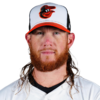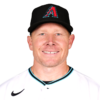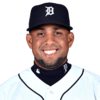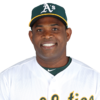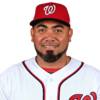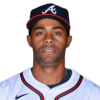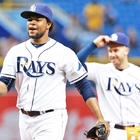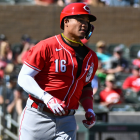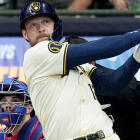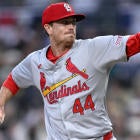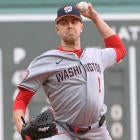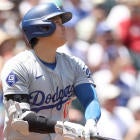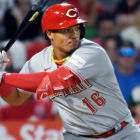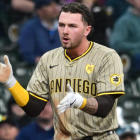Most of the time, it doesn’t make a ton of sense to invest in high-end relievers in Fantasy. The elite guys can absolutely put you well ahead of the pack, but a few factors make them unreliable investments.
First of all, they’re pitchers, which means they are always prone to injury. The workloads aren’t anything close, but relievers are working at max effort at all times, and often find themselves pitching three days in a row, or four times in five days, so the stress on those fragile elbow ligaments is only slightly less than it is for starts.
Second of all, they’re pitchers, which means they are always prone to randomness. Because so much is out of their control, pitchers’ results are, on the whole, more difficult to predict than batters. Add in that relievers’ sample sizes are so much smaller, and you’re looking at a situation where three or four bad outings can really tank a season.
Relievers are volatile creatures, and risk is something you should generally avoid if you can. It’s fine to take on risk late in drafts, but at this point, 18 relievers are coming off the board in the first half of your standard 12-team Roto league. That may not be the best risk management.
We can’t predict performance perfectly for anyone, but especially not for relievers. What we might be able to do is at least figure out who has the most and least risk among them. What I tried to do was group relievers by situation, from the proven elite guys with no questions about their role all the way down to those competitions that are still wide open in the first weeks of spring training.
This isn’t necessarily a ranking of every closer in the league, though it will start out that way. Things diverge after the first group, though I did at least try to rank each pitcher within his own tier based on the order I would target them in. Generally speaking, more strikeouts and more wins are going to mean better things for a pitchers’ outlook.
Landing the right closer can make a big difference, but it can be a tough thing to figure out. Hopefully this helps provide a bit of clarity.
The No-Doubt-About-It Guys
| 1 |
Kenley Jansen
L.A. Dodgers RP
|
You can pretty much take your pick of the top closers here. Kenley Jansen gets the slight edge over Chapman for me, because I expect the Dodgers to be a decent amount better than the Yankees, but you can just flip a coin. | |
| 2 |
Aroldis Chapman
N.Y. Yankees RP
|
In five seasons as closer, Chapman has averaged 36 saves and 109 strikeouts, with a 1.84 ERA. If you want to take him as the top closer, it makes perfect sense. | |
| 3 |
Zach Britton
Baltimore RP
|
With a 1.38 ERA and 40 saves per season since becoming the closer, Britton might actually be better than either Chapman or Jansen in those categories. He plays for a likely playoff contender and is about as good as relievers come, but there’s a pretty wide gap between expected strikeouts here, which is all it takes to drop him to third. Not a bad consolation prize if you want an elite closer. | |
The Very-Very-Small-Doubt-About-It Guys
| 1 |
Edwin Diaz
Seattle RP
|
I don’t need to see much more from Diaz to rank him among the top closers, however he wasn’t quite elite in his MLB debut in 2016; his 2.79 ERA and 1.161 WHIP are a clear step below that tier. However, he was every bit Jansen or Chapman’s equal as a strikeout pitcher last year, and could be the kind of reliever who strikes out 110 batters for a playoff team. He just doesn’t have the track record yet. | |
| 2 |
Wade Davis
Chi. Cubs RP
|
The only question with Davis is health, as he has had forearm issues in each of the last two seasons. When healthy, he’s in the discussion for the best reliever in baseball, with a 1.18 ERA and 0.892 WHIP over the last three seasons. Pitching for a Cubs team that is the odds on favorite to lead the league in wins only helps. | |
| 3 |
Craig Kimbrel
Boston RP
|
Kimbrel hasn’t looked quite as dominant over the last two years, and a knee injury really seemed to bother him last season, leading to his worst full season yet. Of course, he still saved 31 games and struck out 83 batters in 53 innings, so there’s only so far he can seemingly drop. | |
| 4 |
Ken Giles
Houston RP
|
A few bad outings really ruined Giles’ season, and he ended up with a 4.11 ERA and 1.294 WHIP in his first year with the Astros. However, he still struck out 14 batters per nine, and still carries a 2.48 ERA over 181 1/3 innings in his career, so it’s not hard to see how he might have top-3 potential. However, if Giles slips up, the Astros have plenty of options to step into the role, beginning with Will Harris and Luke Gregerson. | |
| 5 |
Jeurys Familia
N.Y. Mets RP
|
If not for a potential suspension for an offseason domestic violence incident, Familia would probably be in the top tier. Don’t be afraid to draft him, but know you might need a fill in for the first month or so. Addison Reed is a nice late-round flier. | |
| 6 | 
Cody Allen
Cleveland RP
|
Having the best reliever in baseball backing you up might not give you a ton of leeway to struggle, however the Indians seem content to use Andrew Miller as a do-it-all fireman, so Allen’s ninth-inning job may be safer than it seems. Miller may | |
| 7 | 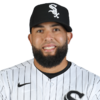
Kelvin Herrera
Kansas City RP
|
There’s a pretty good Herrera is being dramatically undervalued coming into the season, as his strikeout rate took a big jump forward last season to 10.8 per nine. With a 2.30 ERA over the last three seasons in at least 69 2/3 innings, he is pretty safe, and doesn’t have much competition at all in Kansas City. | |
The Guys Who Are Just As Good As The Previous Guys, With Less Risk
| 1 |
Seung-Hwan Oh
St. Louis RP
|
It was only one season, but Oh was dominant in his major-league debut in 2016, posting a 1.92 ERA with 103 strikeouts in 79 2/3 innings. A limited track record in the majors is all that keeps him from the top tier, and given his success in Japan and Korea, even that might not be giving him enough credit. | |
| 2 |
Mark Melancon
San Francisco RP
|
You won’t get the elite strikeout rate with Melancon, but that’s about the only knock you can make on him at this point. He has a 1.80 ERA over the last four seasons, and gets to take his extreme homer prevention to San Francisco, one of the best pitchers parks in the league. He should thrive for a playoff contender. | |
| 3 |
Roberto Osuna
Toronto RP
|
Osuna is kind of the opposite of Melancon; tons of strikeouts, but he has trouble keeping the ball in the yard from time to time. When it comes out to a 2.63 ERA and 3.11 FIP in his first 143 2/3 innings in the majors, it’s hard to complain, especially when it comes for a playoff team with little other competition for the ninth inning. | |
| 4 |
Alex Colome
Tampa Bay RP
|
Colome could end up the best value at the position this season, because he doesn’t get enough credit for the leap he made last season. He made the jump from interesting-but-flawed starter to lights out reliever, and has a 2.13 ERA with 115 strikeouts in 101 1/3 innings since becoming a full-time reliever in 2015. The Rays won’t win many games, but he saved 37 on just 68 wins last season, and there are reasons to think they should be better in 2016. | |
The Potentially Very, Very Good Guys Who Could Lose Their Job With One Bad Week
| 1 |
A.J. Ramos
Miami RP
|
Ramos certainly can be a high-end closer, with 72 saves and a 2.55 ERA (2.95 FIP) over the last two seasons. However, because he often struggles with his control, he is a volatile ninth-inning option, prone to blowups. On some teams, that might not be a huge concern, but the Marlins are built around their bullpen depth this season, meaning they have no shortage of replacement options, starting with Kyle Barraclough and his 36.9 percent strikeout rate. | |
| 2 |
Shawn Kelley
Washington RP
|
If he gets the job, Kelley should be a very good ninth inning option for the Nationals, coming off a season with a 2.64 ERA and 12.4 K/9. However, they seem to want to do anything they can do avoid that, which makes it tough to value him properly coming into the season. | |
| 3 |
David Robertson
Chi. White Sox RP
|
Robertson is kind of the opposite of Kelley, in that he’s “proven” he can be a ninth-inning guy, but with just a 3.32 ERA over the last three seasons, he’s a pretty boring one. It is ironic, then, that he seems to be the favorite to take Kelley’s job, via a long-rumored trade between the White Sox and Nationals. | |
The Safe, Boring Guys
| 1 |
Francisco Rodriguez
Detroit RP
|
The ultimate boring, safe closer, Rodriguez has saved at least 38 games in each of his last three seasons, with an ERA between 2.21 and 3.24. The 35-year-old’s best days are behind him, and the Tigers are a candidate to blow the roster up if they aren’t contending, which makes him an obvious mid-season trade risk. However, as long as he’s in a closer’s role, Rodriguez seems liable to just keep doing what he has done for years. | |
| 2 |
Tony Watson
Pittsburgh RP
|
Watson is another reliever who won’t rack up big strikeouts, but that hasn’t been an issue for him yet, as he sports a 2.56 ERA with 8.0 K/9 in his career. He did take a step back last season, posting his worst ERA since 2012 and his worst FIP since 2011, but he doesn’t have much competition for the role, and feels like a safe fallback option as your second or even third closer. | |
| 3 |
Sam Dyson
Texas RP
|
With a 2.45 ERA over the last three seasons, Dyson has certainly prevented runs like an elite reliever. His peripherals are a bit more middling, but with a groundball rate he can push close to 70 percent, he tends to get himself out of quite a few jams. Once again, the strikeouts aren’t where you want them to be, and Matt Bush looms as a potential shut-down reliever if the Rangers lose faith in Dyson, but nothing he’s done so far should make you wary of trusting him. | |
| 4 |
Jim Johnson
Atlanta RP
|
Johnson took a huge leap forward last season, increasing his strikeout rate from 6.75 to 9.46 per nine, while lowering his ERA from 4.46 to 3.06. That’s a pretty big red flag on its own, without even taking into account the fact that he’s 33 and last posted an ERA near 3.00 in 2013. He may have found a new level of success, but skepticism is fair, especially since it didn’t come with a big change in repertoire or swinging strike rate. Johnson doesn’t have much upside, but the good news is, you won’t have to pay much for him. Nor should you. | |
The Default Guys
| 1 | |
Nobody should be excited about drafting Rodney. He’s here because he has a job. Because the Diamondbacks just don’t have any better options. Rodney is really only going to help you in steals, which isn’t worth paying up for. Settle for him. | |
| 2 | |
If the form Feliz showed last season is real, he might not belong here, because he finally started getting strikeouts again. He had real issues keeping the ball in the yard, however, which could be an issue playing half his games in Miller Park. Keep an eye on Corey Knebel, who struggled last season, but has had success in the majors before. | |
| 3 | |
Kintzler isn’t likely to be as disastrous as Rodney, but he is the very definition of a default option. At least Rodney gets strikeouts. Kintzler is a groundball artist who limits free passes, so he could be a decent run prevention option, but there’s just no upside here. The problem is, the Twins really don’t have any other options, with Glen Perkins’ ongoing injury concerns. Young lefty Taylor Rogers showed some nice things out of the bullpen for the Twins as a rookie, so he could get some chances if Kintzler falters. | |
The Guys Looking Over Their Shoulders
| 1 |
Adam Ottavino
Colorado RP
|
When Greg Holland was healthy, there wasn’t a better reliever in baseball, as he posted a 1.86 ERA with 12.6 K/9 over a four year stretch from 2011 through 2014. However, he hasn’t pitched since undergoing Tommy John surgery in 2015, and may not even be ready for the start of the season at this point. Ottavino isn’t just a placeholder, sporting a 2.84 ERA in the tough environment of Coors Field, so there’s no guarantee he gives up the job. Still, if Holland looks like himself, it might be hard to avoid the temptation of handing him the ninth. | |
| 2 |
Brandon Maurer
San Diego RP
|
Maurer has exactly one good season in the majors to his name, as he posted a 3.00 ERA in 51 innings in 2015 for the Padres. However, he has at least looked better by defense-independent pitching stats, hovering between 3.31 and 3.49 in FIP over the last three seasons. If the spike in his strikeout rate last season was real and he can get a little better luck, he might not be a bad option. However, if Carter Capps is healthy, it might not matter, because Capps can be the best reliever in the league if healthy. Write it off as a result of his gimmicky deliver if you must, but the last time we saw Capps in the majors, he had a 1.16 ERA and struck out 58 of 118 batters he faced. If Capps is healthy, it shouldn’t be long before he gets his chance. | |
The Open Competitions
Cam Bedrosian
L.A. Angels RP
|
Let’s all just agree to put positive thoughts toward Bedrosian getting the job out of the spring. He is by no means a sure thing -- he had a 5.81 ERA with 5.3 BB/9 in his first 51 major-league appearances -- however he’s by far the most interesting option in this Angels bullpen. Largely because he seemed to figure things out last season, trimming his walk rate to 3.1 BB/9, while striking out 11.4 per nine and sporting a 1.12 ERA. He is the only thing resembling a difference maker among this group. |

Huston Street
L.A. Angels RP
|
Street has “proven he can do the job,” which doesn’t really mean anything come off a season where he posted a 6.45 ERA at the age of 32. He’s already hurt, and isn’t guaranteed to be ready for the start of the season, which could turn into a blessing in disguise for the Angels, who were likely to just hand him the ninth inning by default. There really wouldn’t be much reason to be interested in Street if he doesn’t save games. |

Andrew Bailey
L.A. Angels RP
|
If the Angels want to go with another person with closing experience, Bailey does fit that bill. However, he hasn’t saved games consistently since 2011, and also hasn’t been consistently any good since as well. He really shouldn’t be a factor, but with Bedrosian’s spring delayed by a groin injury, he just might get a chance. |
Ryan Madson
Oakland RP
|
The Athletics aren’t going to have a ton of save opportunities, but whoever gets the ninth inning will at least have the benefit of pitching half of his games in Oakland, a great pitching environment. Madson did the job well enough last season, but hasn’t been much of a strikeout pitching since getting back to the majors two years ago, making him a pretty boring option. |
Sean Doolittle
Oakland RP
|
The issue for Doolittle is that he just can’t stay healthy, having thrown just 52 2/3 innings over the last two seasons. He has remained a productive pitcher, and enters 2016 with a career 3.07 ERA and 10.5 K/9. If his shoulder holds up, Doolittle has proven he can be one of the best relievers in baseball. Root for him, if you’re rooting for anyone here. |
Santiago Casilla
Oakland RP
|
Going from San Francisco to Oakland might be the only move a pitching joining the Athletics can make that isn’t an upgrade, so Casilla doesn’t get much of a boost here. He struggled with homers last season, but is a “proven” closer, with a 2.42 ERA over the last seven seasons. Casilla is a bit more interesting than Madson, and could be a nice option if they opt to go with someone with experience in the role. |
Ryan Dull
Oakland RP
|
Not a lot went right for the Athletics last season, but they got some pretty good seasons out of their late-inning relievers, and Dull was a part of that. He combines decent strikeout rates and strong control, with the only downside being his inability to keep the ball in the yard. That wasn’t an issue for him in the minors, and playing in Oakland could lead to better results in that regard moving forward. Dull might not be at the head of the line, but with the A’s constantly looking toward the future, it wouldn’t be a surprise to see him get a chance eventually, thanks to some trades. |
Jeanmar Gomez
Philadelphia RP
|
Gomez picked up 37 saves, but it wasn’t a particularly smooth road for him in 2016. His middling peripherals caught up to him, as he posted a 4.85 ERA after three straight seasons in the low-3.00’s. Gomez is proof that being a closer is all you need to be Fantasy relevant, no matter how many other flaws you might have. |
Hector Neris
Philadelphia RP
|
That 100-strikeout plateau is really what separates good relievers from great ones, and Neris got there last season, while sporting a 2.58 ERA in 80 1/3 innings of work. That was the highest strikeout rate Neris has ever had, in the minors or majors, so it’s fair to wonder how sustainable it is. However, given his competition, Fantasy players should hope he gets the chance just in case it’s real. |
Joaquin Benoit
Philadelphia RP
|
Benoit turned his season around with the Blue Jays, going from a 5.18 ERA with the Mariners in 26 appearances to a 0.38 mark in 25 with Toronto. He now has a sub-3.00 ERA in each of his last four seasons and six of the last season, so there isn’t much question he can get the job done, even at his age. He might not have Neris’ upside thanks to strikeouts, but he can hold his own, and certainly brings more to the table than Gomez. |
Raisel Iglesias
Cincinnati RP
|
Everyone’s favorite breakout starting pitcher from a year ago has become everyone’s favorite breakout reliever. Iglesias couldn’t hold up to the workload of a starter, but he was impressive out of the bullpen, posting a 1.98 ERA with 54 strikeouts in 50 innings of work. If the Reds give him the ninth inning on a full-time basis, he certainly has the ability to be an elite closer, but concerns about his ability to work multiple days in a row while staying healthy could be a road block. |
Drew Storen
Cincinnati RP
|
Storen is a tough nut to crack. He has shown the ability to be a high-level late-innings reliever, but has also had stretches where he barely looks like he belongs in the majors. We saw more of the latter last season, as he was tagged for a 5.23 ERA in 51 2/3 innings of work, however he is just one year removed from sporting a 3.44 ERA with 11.0 K/9. Storen doesn’t have much of a long-term future with the Reds, but that might actually help his chances -- a half-season as a closer could really boost his trade value. |
Michael Lorenzen
Cincinnati RP
|
The Reds’ bullpen is filled to the brim with disappointing former top prospect starters who have showed promise pitching out of the pen. That isn’t a great thing for an organization’s long-term wellbeing, but it does give them plenty of high-upside arms to try in the ninth. That’s part of the problem, of course; there is no obvious standout. Lorenzen struck out 48 in 50 innings, with a 2.88 ERA as a reliever, and seems to max out his stuff in the bullpen, which is what you want to see. As with Storen and Iglesias, he could be a useful option, but isn’t someone you necessarily want to draft unless Bryan Price comes out and says he’s the closer. |







